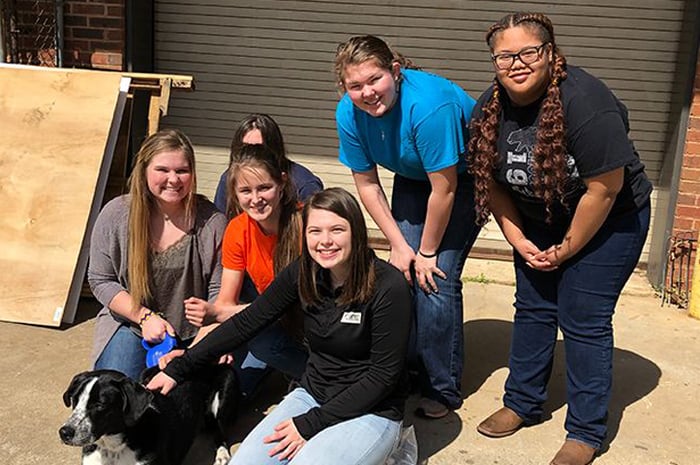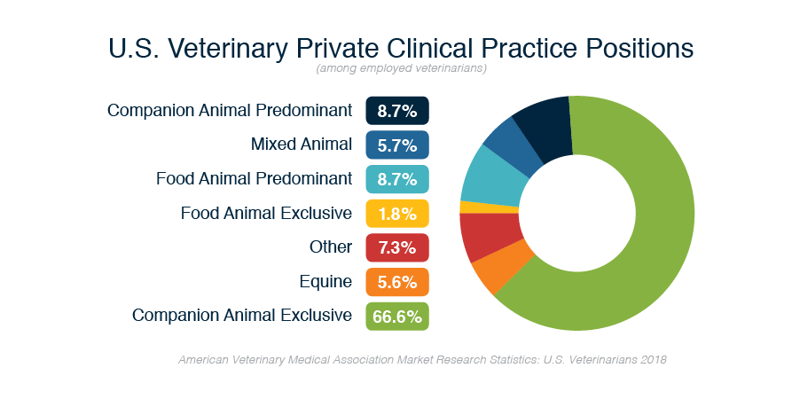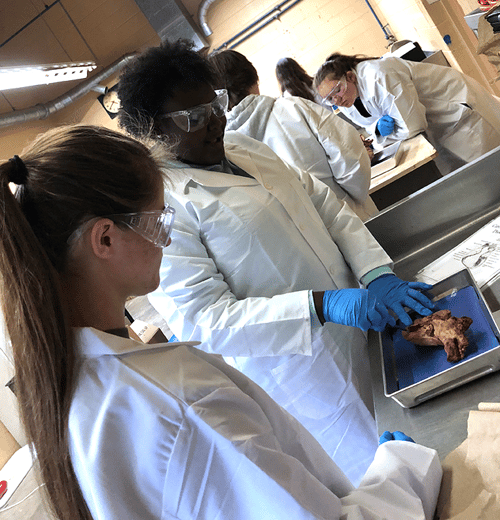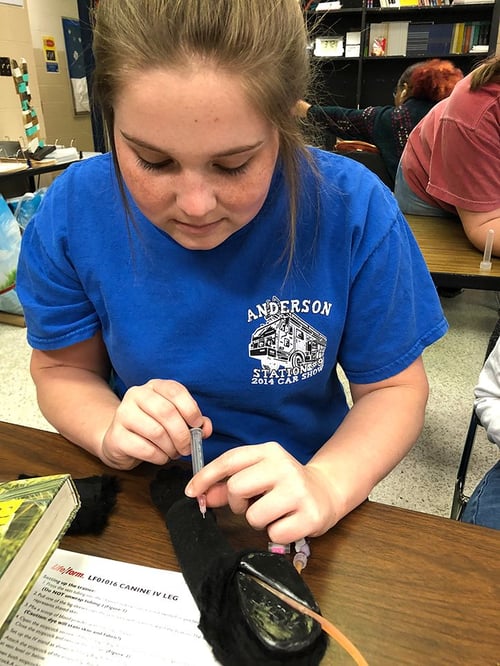CTE Curriculum
Prepare learners with CTE curriculum aligned to industry standards.
Case Study
Elanco Veterinary Medical Applications Certification Prepares Students for Career Success
When Sarah Smith, agricultural science teacher, was outlining the course design for the veterinary medicine class she was adding to the Career & Technical Education course list at Bartlett Yancey High School in Yanceyville, NC, she knew she wanted to use a different approach than the traditional, lecture-focused class. Instead, she decided to follow a flipped classroom model, using the study materials associated with the Elanco Veterinary Medical Applications Certification as the resource her students would use to build knowledge of the principles of veterinary medicine.

Hosted on iCEV, an online platform for Career and Technical Education curriculum and certification testing, the Elanco Veterinary Medical Applications Certification verifies individuals possess a foundational understanding of the competencies needed to achieve employability within the veterinary science industry and is transferable to the health and animal science fields. The certification exhibits mastery in the following industry standards developed by Elanco: veterinary terms and terminology; animal welfare and behavior; anatomy and physiology; and veterinary medical practices. The industry standards are based on Elanco’s 64 years of experience as a global leader in the animal health industry.
Smith decided to include the Elanco Veterinary Medical Applications Certification in the course design because the industry standards aligned with the iCEV Veterinary Medical Applications course she already planned to utilize. Additionally, she wanted to provide the students an opportunity to add an industry certification to scholarship, college or job applications.
Before each class meeting, Smith assigned her students a segment of the study materials for the Elanco Veterinary Medical Applications Certification to review at their own pace and on their own time. Instead of leading lectures during class sessions, Smith facilitated demonstrations, projects and activities that allowed the students to apply the knowledge they gained from the study material. While some of the skill exercises had to be mock due to logistic or liability restrictions, the students participated in some skill labs using live animals. Some local community members brought their pets to the class so students could practice proper animal handling and care, as well as washing and grooming. The students were able to properly perform these skills because of the training they received from the Elanco Veterinary Medical Applications Certification.
While the first part of the course focused on skill development during class meetings, the second half of the class followed a different format. Smith worked with several veterinarians in the surrounding area to allow the students to work in the veterinary clinics to gain a first-hand understanding of the knowledge and skills needed to be a successful employee in a veterinary clinic. The students commuted to their cooperating clinic during the regular class time to assist with and observe a variety of exams and procedures. Because the students demonstrated a strong base of technical knowledge via the Elanco Veterinary Medical Applications Certification and honed their practical skills during class sessions, they were able to be active participants instead of mere observers in the various daily operations of the veterinary clinics.
The Growing Need
 There is a need for more trained professionals in the veterinary medicine industry. According to the American Veterinary Medical Association, there were more than 110,000 practicing veterinarians in 2018, most of whom work in private practice. According to the Bureau of Labor Statistics, employment of veterinarians is expected to grow by 19 percent from 2016 to 2026. To become a licensed veterinarian, individuals must complete a Doctor of Veterinary Medicine (DMV or VMD) at an accredited college of veterinary medicine. Additionally, all states require prospective veterinarians to pass the North American Veterinary Licensing Examination. Many states also require veterinarians to pass a state licensing exam to practice in their specific state. While veterinarians are trained to care for a wide variety of animals, most concentrate their practice on a particular category of animal. Veterinarians specializing in companion animals manage the health of household pets, the most common being dogs and cats. Food animal veterinarians, often referred to as large animal veterinarians, care for animals used for meat and food production, including cattle, swine, sheep, goats and chickens. Public health veterinarians specialize in monitoring and preventing diseases in food animal species to protect animal and human health. Other veterinarians focus on a specific species, such as horses, or oversee the health of wildlife or exotic species.
There is a need for more trained professionals in the veterinary medicine industry. According to the American Veterinary Medical Association, there were more than 110,000 practicing veterinarians in 2018, most of whom work in private practice. According to the Bureau of Labor Statistics, employment of veterinarians is expected to grow by 19 percent from 2016 to 2026. To become a licensed veterinarian, individuals must complete a Doctor of Veterinary Medicine (DMV or VMD) at an accredited college of veterinary medicine. Additionally, all states require prospective veterinarians to pass the North American Veterinary Licensing Examination. Many states also require veterinarians to pass a state licensing exam to practice in their specific state. While veterinarians are trained to care for a wide variety of animals, most concentrate their practice on a particular category of animal. Veterinarians specializing in companion animals manage the health of household pets, the most common being dogs and cats. Food animal veterinarians, often referred to as large animal veterinarians, care for animals used for meat and food production, including cattle, swine, sheep, goats and chickens. Public health veterinarians specialize in monitoring and preventing diseases in food animal species to protect animal and human health. Other veterinarians focus on a specific species, such as horses, or oversee the health of wildlife or exotic species.As the need for licensed veterinarians increases, the demand for supporting veterinary staff also rises. The Bureau of Labor Statistics identified more than 100,000 veterinary technologists and technicians in 2018. The job outlook for veterinary technicians and technologists is expected to grow by 20 percent from 2016 to 2026, according to the Bureau of Labor Statistics.
While veterinarian technologists and technicians have similar roles and responsibilities in the veterinary medicine industry, veterinary technologists typically focus on laboratory and research-based work, while veterinary technicians more commonly perform exams and procedures under the observation of a licensed veterinarian. Most employers require veterinary technologists to hold a four-year degree from a science-based program, such as biology, biochemistry, animal science or veterinary technology. Many of these collegiate programs are accredited by the American Veterinary Medical Association. Veterinary technicians typically hold a two-year degree. Most states require veterinary technologists and technicians to pass the Veterinary Technician National Examination (VTNE) which is offered by the American Association of Veterinary State Boards.
According to the Bureau of Labor Statistics, the demand for veterinary assistants is expected to increase by 19 percent from 2016-2026. Like veterinary technologists and technicians, veterinary assistants help facilitate exams and procedures; however, veterinary assistants typically oversee the pre-and-post-procedure care while veterinary technologists and technicians are more actively involved in the completion of the actual exam or procedure. For most veterinary clinics, a minimum of a high school degree, or equivalent, is required for veterinary assistants. While it is not mandatory, aspiring veterinary assistants are encouraged to acquire the Approved Veterinary Assistant (AVA) designation offered by the National Association of Veterinary Technicians in America (NAVTA). To earn this distinction, individuals must graduate from a NAVTA-approved program and pass the required exam. Several states have veterinary assistant certification, accreditation, registration or licensure programs.
The Bureau of Labor Statistics projected more than 51,000 jobs will be added to the veterinary medicine industry by 2026. This growth rate is almost three times faster than the seven percent average expected for all occupations. This increasingly positive job outlook is primarily due to the growth of the companion animal population, as well as the expansion of treatment and maintenance options for all animals. These factors have led to an increase in consumer spending on animal-related expenses. As the number and variety of companion animals continue to increase, so does the amount of care required for these animals, leading to an increasing need for professionals in the veterinary industry. As reported by the American Veterinary Medical Association, of the approximately 73,000 veterinarians working in private practice, 75 percent focus on companion animal care. Only 10 percent concentrate on food animal species and almost 6 percent operate mixed animal (e.g., companion and food animal) practices. The remaining veterinarians focus on equine care or specialize in specific species care. As seen by the distribution of food to companion animal veterinarians, there is a need for more veterinarians concentrated on the health and care of food animals.

Because the majority of food animals are produced in rural areas, a shortage of rural veterinarians has been observed across the country. In 2019, the USDA National Institute of Food and Agriculture identified 190 regions in 44 states that are experiencing a shortage of food animal or public health veterinarians. The shortage of practicing veterinarians in these areas is not just of concern for rural residents. A lack of food animal and public health veterinarians can lead to increased vulnerability of disease outbreaks, which threatens the health and well-being of humans and animals. A variety of factors, including location, salary and debt, have led to underserved populations in rural areas. Based on the overall demand for veterinary professionals, combined with the need for more food animal-focused, rural-based veterinarians, more individuals must be trained in the technical knowledge and practical skills needed to achieve success in the veterinary medicine industry.
Meeting the Industry Need
While Smith’s class at Bartlett Yancey focused on developing the skills students need to work as a veterinary assistant, the principles addressed in the Elanco Veterinary Medical Applications Certification assure individuals are prepared for a variety of areas in the veterinary medicine industry, as well as careers in the health or animal science fields. Individuals earn the Elanco Veterinary Medical Applications Certification by passing a 100 question exam that assesses an individual’s knowledge and skills of the industry standards produced by Elanco.
Smith attested her students were able to achieve success in the veterinary clinics by completing the Elanco Veterinary Medical Applications Certification.

Because the students had competency in a variety of veterinary skills from the certification and Smith’s class, they were more qualified and prepared for positions in the veterinary clinics than an individual who had not completed the Elanco Veterinary Medical Applications Certification.
Two of Smith’s students found particular success as a result of their experiences in the veterinary medicine class. After completing her class hours at the Cherryville Animal Hospital in Cherryville, NC, Katherine Eastep was officially hired as a part-time veterinary assistant at the clinic. Once the school year ended, Eastep continued to work at the Cherryville Animal Hospital and plans to work there throughout her senior year at Bartlett Yancey. The money Eastep earns at the Cherryville Animal Hospital will go toward her college tuition and savings fund.
Before entering the veterinary assistant class, Kaleigh Grafton had some experience in veterinary medicine due to the shadowing hours she had completed at a veterinary clinic in Yanceyville, NC. Due to this experience, she was placed at the Danville Family Vet practice in Danville, VA to earn her class hours. After a short time at the Danville Family Vet, Grafton filled the vacant veterinary assistant position at the clinic. This employment opportunity allowed her to meet the class requirements while earning a part-time wage. Grafton graduated from Bartlett Yancey but continued to work for the Danville Family Vet practice before she left for college at the University of North Carolina Wilmington to study biology. She plans to transfer to North Carolina State University to enroll in the veterinary medicine program.

Students like Eastep and Grafton are examples of the success that can come from enrolling in Career and Technical Education (CTE) courses and earning an industry certification. Industry certifications are a way for individuals to prove the competencies they have gained from CTE to a potential employer. By listing an industry certification on a résumé or application, an individual can validate the knowledge and skills he or she possesses. Findings from the National Bureau of Economic Research show employers are becoming more specific about the skills they require of their employees. According to Advance CTE, 46 percent of employers have difficulty hiring skilled applicants, which can lead to a $14,000 loss per job for businesses experiencing hiring challenges. A study from the Society of Human Resource Management reported nearly 60 percent of employers have vacant positions for more than 12 weeks.
CTE courses address these issues by providing individuals with opportunities to hone their employability skills before entering the workforce and enable employers to find more skilled and prepared employees who require less on-the-job training. Hiring a well-trained, highly knowledgeable employee reduces the need for extensive on-the-job training, saving employers valuable time, financial and human resources. According to the Association for Talent Development (ADT), an average investment of $1,252 and 33.5 hours is required to train a new employee.
Not only do industry certifications hold value during the job search process, they also assist individuals throughout their careers. Holding a valued and recognized industry certification can lead to salary increases and quicker promotions. The Association for Career and Technical Education (ACTE) reported individuals with industry certifications were more likely to be employed one year after earning a certification and more likely to have been awarded a salary increase. Some cases reported raises as high as 42 percent.
By providing her students with the opportunity to earn the Elanco Veterinary Medical Applications Certification, Smith has set her students on a track for success. Whether they pursue a career in veterinary medicine, animal production or health science, the students from the veterinary medicine class at Bartlett Yancey have the tools to succeed in a variety of fields and professions. Not only do they have the backing of an industry-leading company certifying their competency in the principles of veterinary medicine, they have also exhibited a dedication to the industry, perseverance in furthering their education and many other essential employability skills needed to succeed in the professional world. By earning the Elanco Veterinary Medical Applications Certification, the students from the veterinary assistant class at Bartlett Yancey are ready to enter the workforce as highly skilled and knowledgeable employees.
BARTLETT YANCEY HIGH SCHOOL
YANCEYVILLE, NORTH CAROLINA
About iCEV
Since 1984, iCEV has specialized in providing quality CTE curriculum and educational resources. iCEV is the most comprehensive online resource for CTE educators and students, offering curriculum for several major subject areas, including agricultural science, trade & industrial education, business & marketing, career exploration, family & consumer science, trade & health science, law enforcement and STEM education. iCEV also acts as a certification testing platform for industry certifications. Recognized companies and organizations utilize iCEV as the testing platform for their certifications. Additionally, iCEV offers Eduthings, a CTE data management platform that simplifies reporting for industry certifications, work-based learning, CTSO participation, and more. For more information, visit www.icevonline.com.




